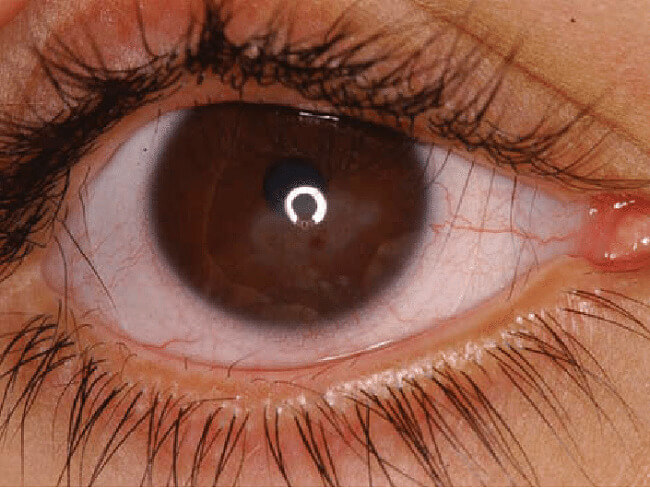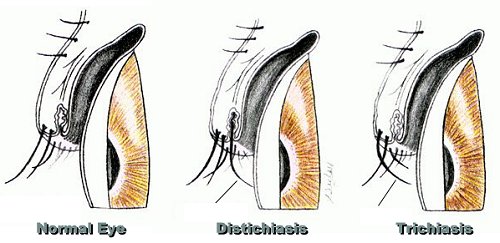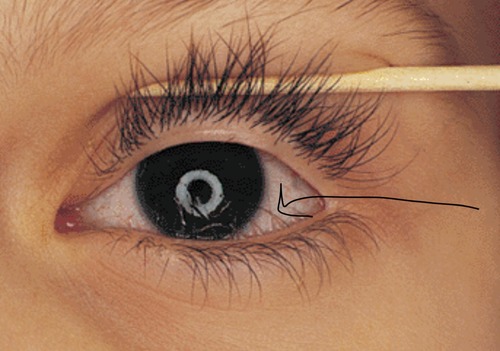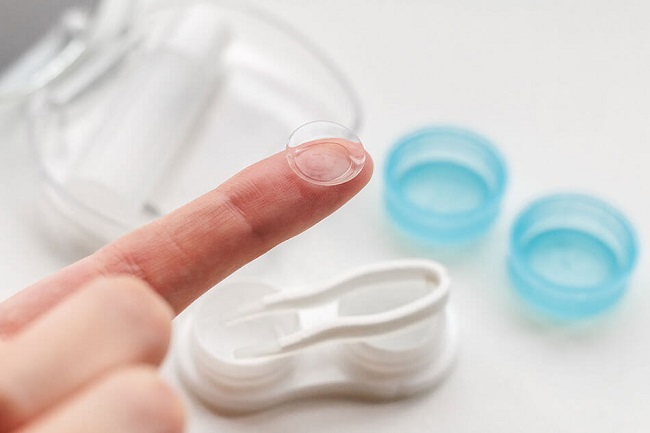What are double eyelashes? How to define distichiasis which functions as a medical term for double row of eyelashes? How rare are double eyelashes?, etc. There have been thousands of questions about distichiasis vs normal eyelashes, as well as that which sounds like: “What do double lashes look like?” If you have been unaware of this medical condition or suspect that you may have the genetic mutation yourself, this article will provide you with valuable information about, how to know if you have double eyelashes and an appropriate distichiasis treatment, as well.

What Are Double Eyelashes (Or Distichiasis)?
Double eyelashes, also known as distichiasis, is a rare eye condition, which is characterized by the presence of two rows of eyelashes. The second row will consist of either a single lash or a few hairs, or a complete lash set. Distichiasis often impacts the top and lower eyelids alone, although it may sometimes affect all four eyelids. The extra eyelashes grow from meibomian glands which are located around the edge of the eyelid. By coating tears with an oily material, the glands functionally prevent excessive evaporation of tears. You will ask us something like: “How do double rows of eyelashes vs normal eyelashes differ from one another?”, won’t you?
In comparison to normal eyelashes, double eyelashes, often are thinner, shorter, and lighter in color. In order to determine if you do have the genetic mutation causing a double row of eyelashes, you can quickly and easily look at your waterline. By pulling back your eyelids, you might see whether there are any hairs growing along the waterline, or if your eyelashes abruptly stop at that point. It’s exactly how to know if you have double eyelashes, so make some notes! If you notice the emergence of any additional eyelashes along your waterline, it may indicate the presence of a genetic variation associated with double eyelashes. One of your parents likely has this eye condition since it is inherited, and follows a dominant gene pattern.
You will also tell that the lash line looks to have a double lash line, or double layer of eyelashes when you compare any pictures of two rows of eyelashes with those of normal lashes on the Internet. As the name “double eyelashes” is already clarified, you now all must know: how to tell if you have double eyelashes, right? Interestingly, the beauty industry’s use of this term to describe adhesive falsies is somewhat peculiar, as it often differs from the natural occurrence of those double eyelashes. Medically, still, bear in mind the term “distichiasis” since it’s the core of the eye issue discussed among us.

What Are The Symptoms Of Double Eyelashes?
The indications of double eyelashes can vary depending on the quantity of one’ extra lashes, the texture of the lash hair, and the direction of lash growth. The key indication of distichiasis involves the presence of additional hair follicles, which produce lashes either above or below the normal lash line. The following are some common symptoms associated with this condition:
- Extra eyelashes situated above or below the regular lash line, bacterial infection in the eye
- A dense lash line, redness and irritation in the eyes, discomfort in the eye, irritated eyelids, excessive tearing, impaired vision, inflammation of the eyes, and in extreme cases, potential vision loss
If left untreated for a longer period, these symptoms can result in more severe complications. Keep in mind that even though it is uncommon, vision impairment is a potential outcome. Regardless of whether the abnormal lashes grow naturally or towards the surface of the eye, it is essential to have them removed to prevent corneal scratches and discomfort. Traditional removal techniques are not effective as new hairs will grow back after about 3 weeks. Cryosurgery is a more long-lasting alternative, where a doctor may apply extreme cold to the affected areas to eliminate the unwanted lashes. If you experience vision problems, it is ideal to consult with a professional eye doctor.
>> Do not confuse double eyelashes with lash layers. Read our following article to understand better: What Are Lash Layers?
Causes Of Double Eyelashes (Or Distichiasis)
There are two primary ways in which double eyelashes can be owned. The first is congenital distichiasis, which means being born with it. The second is acquired distichiasis, which might develop later in life.
1. Present At Birth
Congenital distichiasis occurs when a cell within the epithelium, (the protective system of the organs) transforms into a pilosebaceous unit which encompasses a hair follicle, among other components. In specific cases, a mutation in the FOXC2 gene, responsible for the growth of various organs and tissues before birth, can cause this form of double eyelashes. Congenital distichiasis also indicates the existence of a rare genetic eye condition, known as lymphedema-distichiasis syndrome (LDS), characterized by the accumulation of fluids, which is called lymphedema.
2. Develop Later In Life
Acquired distichiasis arises from eyelid injurie or inflammation. This type of double eyelashes might be caused by factors, such as chemical eye damage, blepharitis or inflammation of the eyelids, meibomian gland dysfunction (MGD) contributing to dry eye. Other causes may be ocular cicatricial pemphigoid (OCP) – an autoimmune disorder causing scarring in your eyes, mouth, and throat. Some of its most frequent visual side effects, which range in severity from fuzzy vision to intraocular hemorrhage and optic neuropathy, are itchy, watery, and dry eyes. Or Stevens Johnson syndrome (SJS),an unusual and severe condition resulting in skin layers detaching and shedding. Its rashes may cause the conjunctiva/cornea to become inflamed, light-sensitive, red, or to develop painful ulcers.

What Can Be An Effective Distichiasis Treatment?
In cases where there are no symptoms, treatment for double eyelashes is just unnecessary. However, if there are, the focus of treatment will be on managing them which will involve the removal of the extra eyelashes. The most proper treatment is often based on the number of those extra lashes and the specific symptoms behind.
- Lubricating Eye Drops: For mild cases, the use of lubricating eye drops can help alleviate eye irritations by providing extra moisture and protecting the cornea from two rows of eyelashes.
- Soft Contact Lenses: Similar to lubrication, soft contact lenses create a protective barrier to minimize all discomfort and irritation. It is vital to use contact lenses correctly to avoid complications. An optometrist or ophthalmologist can provide guidance on the proper use of contact lenses.
- Epilation: Epilation involves using an electronic device called an epilator to physically pluck out most of the extras from double lashes. However, this is a temporary method as the eyelashes tend to regrow, within two to three weeks. Epilation is commonly recommended for cases with only a few extra lashes.
- Cryotherapy: Cryotherapy involves using extreme cold to destroy the eyelash follicles. This way is suitable for cases with a significant number of double lashes. While cryotherapy provides long-lasting results, it can lead to side effects like loss of nearby eyelashes, thinning of your eyelid edges or eyelid scarring, and lid depigmentation.
- Electrolysis: Similar to epilation, electrolysis is effective for removing a small number of extra lashes. This procedure involves inserting a needle into the eyelash follicle as applying a short-wave often destroys the follicle.
- Lid Splitting: This is a surgical treatment for double eyelashes where your eyelid is opened to expose your eyelash follicles which allows for the individual removal of the extra lashes. This is combined with cryotherapy or electrolysis in certain cases.
- Argon Laser Thermal Ablation: This double eyelashes treatment often starts by applying repeated burns from an argon laser to the lash follicles, resulting in their destruction. During this treatment, some mild discomfort and increased tear flow may be experienced.
The choice of treatment will depend on the severity of the condition and the specific needs of each patient. Remember that you still need to consult with an eye care professional to select the best eye treatment for distichiasis. >> Learn more about a disease of the eyelashes that also greatly affects eye health: Ingrown Eyelash – Not As Easy As It Looks!

FAQs
Who Are Found To Have Distichiasis?
The chance to possess double eyelashes is often based on a number of factors. In the case of congenital distichiasis, having a family history of double eyelashes increases the chances of acquiring this condition. On the other hand, acquired distichiasis is more common in older people. As certain conditions leading to this form of double eyelashes tend to occur with age.
Also, women have a higher risk of having distichiasis, as ocular cicatricial pemphigoid (OCP) is twice as likely to affect women. Those experiencing eyelid inflammation or usually wearing contact lenses also have an increased likelihood of getting double eyelashes as such factors are associated with meibomian gland dysfunction (MGD).
How To Diagnose Double Eyelashes?
Distichiasis, or double eyelashes, can be diagnosed by a healthcare professional through an eye examination that incorporates a slit-lamp test. This specialized microscope helps enable the provider to observe the eye under magnification.
As certain symptoms of distichiasis can overlap with other eye conditions, such as entropion (the inward turning of eyelids), additional tests will be essential to confirm the diagnosis. The healthcare provider of yours will determine to order further testing to ensure an accurate and definitive diagnosis, as well.
Conclusion
At first glance, one might assume that having double eyelashes would be advantageous. In fact, this is not necessarily harmful, but may result in eye discomfort and irritation. In severe cases, a more serious condition may be present. Therefore, early detection allows for timely treatment and relief from uneasy symptoms of distichiasis.
It’s somewhat perplexing that the beauty industry has adopted double eyelashes since many celebrities are renowned for having this condition. Now, there are still people affected by this eye condition, but in most cases, it doesn’t lead to any issues or unwanted complications. So just follow our guides above whenever you feel like having distichiasis.
Visit our website for more updated information: https://vietnamlash.com/


